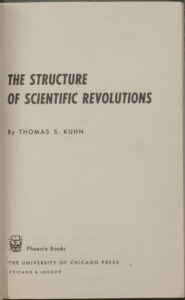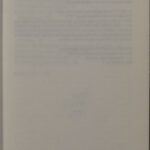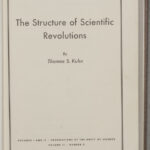The Oxford Companion to Philosophy calls The Structure of Scientific Revolutions “the most influential book in modern philosophy of science.” Published originally in 1962 as part of the International Encyclopedia of Unified Science, the book was apparently begun while Kuhn was still a graduate student at Harvard, where he earned the Ph.D. in physics in 1949.
The work has had a profound impact on the study of philosophy, economics, sociology, and of course history of science. Indeed it’s difficult in a context such as this brief, book-a-year survey of the MIT Libraries’ holdings, to do justice to Kuhn’s work and its massive influence.
This much, though, can be said: if you’ve ever used the phrase “paradigm shift” – or just the word “paradigm” by itself for that matter – or if you’ve ever lamented its overuse by others, well, you have Thomas Kuhn to thank (or blame).
In this volume, Kuhn argues that the typical scientist, far from the stereotype of the unconstrained visionary in constant pursuit of the unexpected or novel, is in fact a relatively conservative creature. This is partly because science takes place within, and thus is naturally tied to, a specific scientific culture that’s defined by a prevailing set of widely-accepted beliefs. That enveloping environment, that agreed-upon theoretical framework, is the “paradigm” within which “normal science” (Kuhn’s term) is conducted.
Paradigm shifts – for example, Copernicus’ challenge to Ptolemaic cosmology – are essentially revolutions that overthrow the prevailing “normal science.” It isn’t surprising that such shifts are often resisted, at least within certain quarters. With time, the “new paradigm” becomes the new normal, which may itself be supplanted in turn by yet another paradigm shift.
It appears to be terribly simple, but brilliant insights often do, as long as someone else has done the difficult work of making it seem simple. Kuhn’s book was, and remains, controversial, but no one argues with its sheer brilliance. Atypically for a book of such seriousness and relative complexity, The Structure of Scientific Revolutions has been republished repeatedly, has sold over a million copies, and has been translated into numerous languages.
After teaching at Harvard, Berkeley, and Princeton, Thomas Kuhn joined the faculty at MIT in 1979, where he taught philosophy and the history of science until his retirement in 1991. His papers are held by MIT’s Institute Archives and Special Collections, and unsurprisingly, they are heavily used by researchers from around the world.



